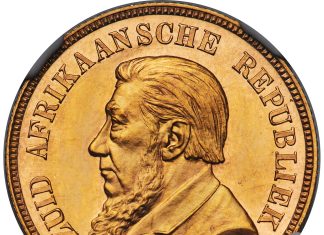 Gold futures prices turned higher and back above $1200 an ounce after falling below the psychological barrier early on Wednesday.
Gold futures prices turned higher and back above $1200 an ounce after falling below the psychological barrier early on Wednesday.
U.S. gold for December delivery was up $9.20 to $1207.20 an ounce at 10:20 a.m. EDT.
In other precious metals, silver for September delivery was at $18.125 an ounce for a loss of 3.3 cents, while October platinum was up $1.60 to $1,538.60 and palladium for September delivery rose $2.25 to $472.85 an ounce.
Following immediately is the daily precious metals commentary, compliments of Jon Nadler, senior analyst at Kitco Metals, Inc.:
Good Morning,
Whatever immediate support gold prices received from the Fed’s decision to throw a small bone at the markets, quickly dissipated overnight, and the yellow metal headed towards more ‘comfortable’ territory under the $1,200.00 pivot point by early this morning.
This is not to say that gold will immediately fall below $1190.00, or that the bulls will give up trying to push the market higher once again (they are already hard at work, trying to do just that, this morning). It is just that conventional wisdom turned out to be as incorrect (see yesterday’s bold declaration that the Fed is implicitly ‘good for gold’) as ever when it assumed a knee-jerk $30+ upward move in the metal right after the Fed gaveth. It gaveth all right, just not enough, in the opinion of some.
At the end of the day, the realization that the Fed is basically out of scalpels and forceps with which to perform any further surgical miracles on the US economy drove market participants back into the US dollar as the safe haven which might see them through what is apparently a bout of inevitable deflation waiting on the doorstep. Behold the greenback staging its largest rally in sixty days after a Fed statement that was basically interpreted as one or another form of easing (!).
The US currency rose 1.2% against the euro (the common currency is now back to $1.30), and it gained 0.79 on the trade-weighted index overnight, climbing to 81.67 at last check. Counterintuitive, you say? Not so fast, say others. One quick glance at the losses in global equity markets this morning shows that investors have taken the Fed’s stance to mean ‘Yup, we got slow growth (trending towards no-growth) and there is only so much we are willing to do to avert that.’ Risk assets fell out of fashion quicker than ponytails on men in the wake of the Fed’s less-than-accommodative gesture last night.
The US economy is not alone in exhibiting such unwelcome (by central bankers) conditions, by the way. The outlook for Great Britain contains inflation projections of 1.5% (under the BoE’s target) and although the economy grew at a 1.1% pace in Q2 (more than anticipated), the BoE’s Governor, Mr. King, opined that future UK growth might turn out weaker than was previously expected. And now, China is slowing as well, albeit the rate to which it might decelerate would still qualify for the title of ‘highly enviable’ among any global economic powerhouse.
Lower US growth implies dollar strength. Dollar strength implies lower gold prices. The negative gold-dollar correlation that had been on vacation during Q2 is now back on the scene and the gold market is the one that has to contend with it (given its otherwise poor fundamentals).
In addition, gold is also showing that its commodity component is still in force. Another $1+ decline in crude oil and assorted looses in base metals (based on the same US + China slow growth fears) helped drag bullion lower as well. Ignore such correlations (negative or positive, but still valid) at your portfolio’s own risk.
Spot bullion prices opened lower across the board for the midweek session in New York. Gold lost $2.30 per ounce, starting the day off at $1201.50 after having touched a low at $1194.70 bid overnight. Interest in the dollar and ebbing risk appetite are providing a fairly weighty lid on top of the market for the time being. Gold, once again, is a metal in search of a fresh crisis, or some (any) news that the bulls can make a short-term run with, such as last week’s Chinese gold market deregulation hoopla.
Silver fell 12 cents on the open, quoted at $18.19 per troy ounce. Not much pain (to the downside) no gain (to the upside in the wake of a slowing US/Chinese/UK/etc. economy) either. Platinum lost $8 to start at $1533.00 while palladium dropped $3 to the $472.00 mark. No change in rhodium, still quoted at $2,100.00 per ounce. Crude oil hovered just under $79.50 while stock futures were indicating another session of declines ahead on the radar.
The US trade deficit figures released this morning further bolstered the US dollar and Treasurys. The US import/export gap grew wider in June to a hair under $50 billion. Before one casually dismisses that figure, please note that it was achieved mainly on the back of falling exports and that it is the largest such shortfall since the infamous Lehman implosion. Dow futures were seen as obsessing about a string of bearish-sounding data of out Asia and ignoring happy (quarterly performance) news from the Magic Kingdom. Well, at least all is well in the wide world of wrestling (some of you wanted to know the outcome of that match).
For today’s wrap-up, Marketwatch’s Rex Nutting brings us his take on the easing that wasn’t. Writes Mr. Nutting:
"It’s pretty clear that quantitative easing isn’t a very efficient way to stimulate the economy. The Fed may try it again, but we shouldn’t be surprised if it’s ineffective.
The Fed could just wait for households and small businesses to pare down their debts. Someday, they’ll be ready, willing and able to borrow again. This is the point in the argument when John Maynard Keynes reminded us that, “in the long run, we are all dead.”
The output gap — the difference between where we are and where we should be — isn’t just lines on paper or theories in a classroom; it’s real incomes that aren’t earned, real goods and services that aren’t produced or consumed, real dreams that aren’t realized.
It doesn’t take a poet to know what happens to a dream deferred. Sometimes, it explodes. If the Fed’s hands are tied, are we doomed to a lost decade of deferred dreams?
Happily, no. There is one group that’s still able to borrow: the federal government, which could fill the gap temporarily by directly employing idle people to fulfill some of those deferred dreams. They could teach the children, heal the sick, build the infrastructure, discover new drugs, and invent new technologies.
Unhappily, it’s not going to happen."
And so, let us get back to where we left off, before yesterday’s installment of the "Uncertain Days of Our Lives." The story, thus far: Fred issues a warning to Ben. David has memories of giving birth to the monster that ate the US economy. Market is devastated to hear about Milton’s past. Ben tries to convince Mervyn that he and Brittany are ‘an item,’ and that his marriage to Hope is over. David accuses Richard and Ronald of pumping him for information about Goldie. Marc kisses Jodie and writes it off.
Submit your guesses for our characters to The Onion.
Happy Uncertainties. There is no other choice.
Jon Nadler
Senior Analyst
Kitco Metals Inc.
North America
Original article link: Easy Does It. Not.
www.kitco.comand www.kitco.cnBlog: http://www.kitco.com/ind/index.html#nadler
Editor’s Note: Meet the Kitco Team at the upcoming Kitco Metals eConference September 12-13, 2010. A not-to-be missed event featuring Ron Paul, Marc Faber and other industry heavyweights. The eConference is free with Pre- Registration www.kitcoeconf.com.










